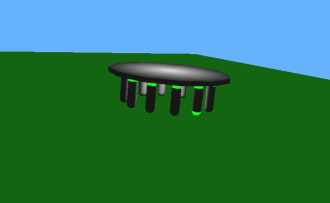Biorobotics Laboratory BioRob

More and more instances of chaotic behaviour are found in biological systems such as the heart or the brain. Roboticists inspired by biology cannot stay ignorant in face of such results. Assuming that nature's prevailing solutions are far from arbitrary the chaoticity must add something essential to those systems. Although there are numerous publications concernig chaos in neuroscience and biology, using chaotic systems for the control of robots rests almost unheard of. In 2004 Yasuo Kuniyoshi and Shinsuke Suzuki [2] proposed a model that employed the well known logistic map as chaotic element. They were able to show that their systems were capable to adapt to environmental changes and nd useful control sequences without explicit learning algorithms. Even though they ascribed their results to the interaction of the non linear system with the environment through embodiment (see also: [3]) conditions and limits for interesting results are yet to be found. This article wants to be a step in this direction and provides some more insight into the original models. To this end the original models are reimplemented and a third model is proposed. In accordance to the original paper the two models are referred to as muscle-joint and insect-like. The muscle-joint model consists of an upper and a lower link which are connected via a joint and twelve muscle bers distributed in equal distances around the joint. Ground and lower link are xed together. The insect-like model is build of a plate to which twelve legs are connected via hinge joints. Controlled are the legs through a torque that is applied at the joint. Furthermore the legs movements are dampened by two springs each.
References:
[1]Yasuo Kuniyoshi and Shinsuke Suzuki. Dynamic emergence and adaptation of behavior through embodiment as coupled chaotic field. In Proceedings of the IEEE/RSJ International conference on intelligent robots and systems, 2004. PDF
 The main idea was to use sensor dependent values as arguments for a chaotic map whose output then determines the signal sent to the actuators. This procedure is performed at discrete times with the time intervall being TC. Thus the n-dimensional robot state is influenced by constant actuation in combination with possibly varying external forces during each intervall.
The main idea was to use sensor dependent values as arguments for a chaotic map whose output then determines the signal sent to the actuators. This procedure is performed at discrete times with the time intervall being TC. Thus the n-dimensional robot state is influenced by constant actuation in combination with possibly varying external forces during each intervall.
For reimplementation I had to overcome uncertainties in the original paper. In consequence parameters could not be reused straight away. An analysis of the equations and acting forces enabled me to greatly reduce the parameter space to be searched and I could reproduce results of the original.
For details of the reimplementation process, as well as the parameter search the reader should refer to my report that can be found below.
On the left here you see a screenshot of my undirected insect_like model, and above one of the muscle joint model. All models were implemented using Webots(TM) and ODE custom physics.
- Archived student projects
- Alain Dysli
- Alexandre Tuleu
- Anurag Tripathi
- Ariane Pasquier
- Aïsha Hitz
- Barthélémy von Haller
- Benjamin Fankhauser
- Benoit Rat
- Bertrand Mesot
- Biljana Petreska
- Brian Jimenez
- Christian Lathion
- Christophe Richon
- Cédric Favre
- Daisy Lachat
- Daniel Marbach
- Daniel Marbach
- Elia Palme
- Elmar Dittrich
- Etienne Dysli
- Fabrizio Patuzzo
- Fritz Menzer
- Giorgio Brambilla
- Ivan Kviatkevitch
- Jean-Christophe Fillion-Robin
- Jean-Philippe Egger
- Jennifer Meinen
- Jesse van den Kieboom
- Jocelyne Lotfi
- Julia Jesse
- Julien Gagnet
- Julien Nicolas
- Julien Ruffin
- Jérôme Braure
- Jérôme Guerra
- Jérôme Maye
- Jérôme Maye
- Kevin Drapel & Cyril Jaquier
- Kevin Drapel & Cyril Jaquier
- Loïc Matthey
- Ludovic Righetti
- Lukas Benda
- Lukas Hohl
- Lukas Hohl
- Marc-Antoine Nüssli
- Martin Biehl
- Martin Riess
- Martin Rumo
- Mathieu Salzmann
- Matteo Thomas de Giacomi
- Matteo Thomas de Giacomi
- Michael Gerber
- Michel Ganguin
- Michel Yerly
- Mikaël Mayer
- Muhamed Mehmedinovic
- Neha Priyadarshini Garg
- Nicolas Delieutraz
- Panteleimon Zotos
- Pascal Cominoli
- Pascal Cominoli
- Patrick Amstutz
- Pedro Lopez Estepa
- Pierre-Arnaud Guyot
- Rafael Arco Arredondo
- Raphaël Haberer-Proust
- Rico Möckel
- Sacha Contantinescu
- Sandra Wieser
- Sarah Marthe
- Simon Blanchoud
- Simon Capern
- Simon Lépine
- Simon Ruffieux
- Simon Rutishauser
- Stephan Singh
- Stéphane Mojon
- Stéphane Mojon
- Sébastian Gay
- Vlad Trifa
- Yvan Bourquin
